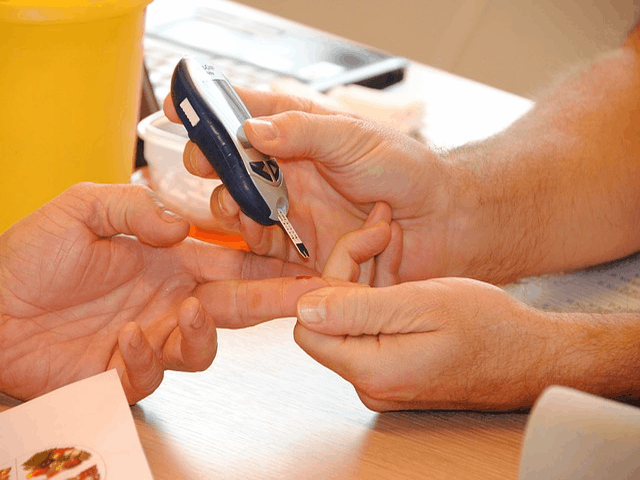All you need to know about type 1 and type 2 diabetes. Possible causes, symptoms, when to consult a physician, disease course and treatment – all we have included in this post.
Type 1 diabetes
A lack of the hormone insulin causes type 1 diabetes.
The body needs insulin to regulate blood sugar, so people with type 1 diabetes depend on receiving insulin via injection or insulin pump.

Image by Photo Mix from Pixabay
Cause of type 1 diabetes
When we eat or take something that holds sugar, the blood sugar will increase as the intestine digest the food. When this happens, the pancreas secretes insulin. Insulin is a hormone that ensures that the absorptions the excess sugar in the blood into muscle tissue or liver; either to energy or to be stored as reserve energy.
In type 1 diabetes, insulin is not appropriately excreted. For reasons we do not know, the body’s immune system damages the cells in the pancreas that produce insulin and destroy them.
There are several theories about why this occurs. Still, it is believed that the disease is usually triggered by a combination of heredity and environmental factors; such as lifestyle, diet, hygiene, and viral infections.
Symptoms of type 1 Diabetes
When the disease develops and insulin production decreases, you get one or more symptoms of high blood sugar (hyperglycemia):
- Increased thirst
- Frequent urination
- Fatigue
- Weight loss
- Blurred vision
- Increased risk of infections of the skin, mouth, or vagina.
In cases where the blood sugar becomes dangerously high, you may
- lose consciousness,
- have abdominal pain,
- become nauseous,
- hyperventilate (deep and rapid breathing) and
- feel that your breath smells of acetone.
When should you contact a doctor?
If you or young people in the family have high blood sugar (see the section above); or if you suspect you have diabetes for other reasons.
Suppose you apply insulin and experience low blood sugar (feeling). Typical mild-to-moderate symptoms are sweating, trembling, difficulty concentrating, palpitations, and pallor. With severe feelings, one can lose consciousness, become confused, and have difficulty seeing and speaking.
Disease course
The time it takes from the body to attack the insulin-producing cells in the pancreas; until they are gone can take a long time. However, the symptoms of diabetes often come on acutely with severe symptoms; especially in those who develop the disease in childhood and adolescence. The disease is chronic, and people with type 1 diabetes, therefore need insulin treatment throughout life.
Suppose you have poorly controlled diabetes and should go with high blood sugar for a long time. In that case, it can damage the blood vessels and peripheral nerves (neuropathy); and increase the risk of several sequelae or late complications.
The most severe diabetes comorbidities are
- kidney disease,
- cardiovascular illness (heart attack, stroke),
- diabetic foot ulcers, and
- decreased legs sensitivity.
People with diabetes are prone to damage to the small blood vessels in the eyes; which can lead to impaired vision and, in the worst case, blindness. Many men with diabetes develop impotence. To overcome impotence, use Fildena 100 under doctors prescription.
Treatment
The purpose of treating type 1 diabetes is to gain symptom-free and high quality of life by having as average blood sugar values as possible; throughout the day and preventing cardiovascular disease and diabetic late complications in the long run. The treatment is on self-care, proper diet, and insulin supply.
Type 2 diabetes

Image by Steve Buissinne from Pixabay
More and more people live with type 2 diabetes, and many have the disease without knowing it. Exercise and weight loss can stop developing type 2 diabetes and are essential measures in treatment together; with a healthy diet and drugs that lower blood sugar.
Insulin is a hormone produced in the pancreas and is essential for absorbing sugar from the bloodstream; to the liver, fat, and muscle tissue. In type 2 diabetes, the insulin produced in the body does not work well enough. Besides, it reduces the secretion of insulin from the pancreas.
Overall, this means you get higher blood sugar than average, and over time; it can lead to essential organs in the body being damaged.
Type 2 diabetes often occurs with other lifestyle conditions, including
- high blood pressure,
- obesity/obesity,
- high cholesterol levels,
- and fats in the blood.
Causes of type 2 diabetes
A combination of heredity and lifestyle causes type 2 diabetes.
- One probably inherits the predisposition to develop diabetes, but lifestyle conditions largely determine whether the disease develops.
- Obesity and physical inactivity double the risk of developing type 2 diabetes.
Incidence of type 2 diabetes
According to the Institute of Public Health, 245,000 (less than 5%) of the population are diagnosed with diabetes.
Twenty-eight thousand of these have type 1 diabetes, while 216,000 have type 2.
It is estimated that there are large dark numbers; and that there are up to 100-200 000 people who have the disease without knowing about it.
The frequency of type 2 diabetes increases with the rising age; likewise, younger people can also have the disease.
Symptoms of type 2 diabetes
The symptoms of high blood sugar can be numerous and diffuse, and they can come on gradually over several years.
- Typically, you will feel more tired and relaxed, and you will have increased thirst.
- Other signs of incipient type 2 diabetes may be an increased urge to urinate; frequent fungal/bacterial infections in the abdomen, increased hunger, and a general feeling of being unwell.
- Some may also feel depressed.
- If you get very high blood sugar, you can become dizzy or; in the worst case, lose consciousness and go into a coma.
When should you contact a doctor?
Be vigilant and contact your doctor if you experience developing symptoms of type 2 diabetes (see above).
This is particularly true if one or more members of your family have the disease.
People with a huge chance of receiving diabetes should see their GP regularly for regular check-ups every year.
Disease course

Photo by Stas Knop from Pexels
You can see long changes in insulin secretion and insulin sensitivity before the symptoms of diabetes appear.
- The signs of type 2 diabetes usually appear gradually over a long time; and the diagnosis is often not done until long after the onset of the disease.
- Suppose you possess had high blood sugar for a long time or have inadequately regulated diabetes. In that case, it can harm the blood vessels and increase the risk of several sequelae or late complications.
The most severe diabetes sequelae are
- kidney disease,
- heart attack,
- stroke,
- diabetic foot ulcers,
- and decreased sensitivity in the legs (neuropathy).
People with diabetes are prone to damage to the small blood vessels in the eyes. That also can lead to impaired vision and, in the worst case, blindness.
Up to 50% of adult men with diabetes develop impotence. You can get Fildena 100 and Fildena 150. This is because of the low blood supply to the penis because of narrowed blood vessels and blood pressure medication.
Note: Do not take Fildena 100 and Fildena 150 until physician recommend and prescribe you. Especially when you have heart diseases.
Preventive advice against type 2 diabetes
If you are genetically influenced by growing type 2 diabetes, you can lessen your risk of deepening the disease by
- eating a healthy diet,
- avoiding obesity,
- and exercising regularly.
You will find specific advice under “Treatment of type 2 diabetes”.
If you are wondering how prone you are, you can take a risk test. Also, that tells you how prone you are to developing type 2 diabetes over the next ten years.
Moreover, it would help if you answered some straightforward questions about
- gender,
- age,
- weight,
- height,
- waist measurements,
- and whether you are using certain types of medications.
Treatment
The purpose of treating type 2 diabetes is
- To achieve symptom-free and high quality of life by having; as typical blood sugar values as possible throughout the day and
- Preventing cardiovascular disease and diabetic late complications in the long run.
The treatment is based on lifestyle measures and the right diet, often combined with drugs that reduce blood sugar.
Self-care advice for type 1 diabetes and type 2 diabetes.

- Learn the body’s signals of too high and too low blood sugar.
- Measure your blood sugar regularly using a blood glucose monitor. Keep a diabetes diary where the blood sugar values are noted.
- Lose weight in case of overweight or obesity. Weight loss and a healthy diet increase insulin sensitivity, lower blood sugar, and low other cardiovascular disease risk factors. The GP can help set up a program with exercise and diet/behavior changes. If this does not help, the GP can refer you to a specialist health service.
- Exercise regularly. At least 150 minutes every week. This may appear like a lot; but if you do a little every day, for example, walking at high speed or cycling to work when you reach the goal fast.
- A mixture of endurance and strength training seems to give the best effect. Rowing, swimming, aqua aerobics, and strength training are beneficial activities if you are untrained or overweight. Find exercises you enjoy and that you have convinced experiences with.
- Blunt smoke. Smoking is an additional risk factor for developing cardiovascular disease and exacerbates complications of diabetes. Ask your doctor if you require help to stop smoking.
- See a doctor regularly to examine your eyes, feet, and kidney function.
- Daily foot care is critical to prevent the development of diabetic foot ulcers.
Must Read: Ten Inexpensive Solutions for Sinus Problems
Featured Image by Steve Buissinne from Pixabay

Comments are closed.